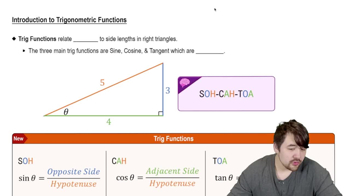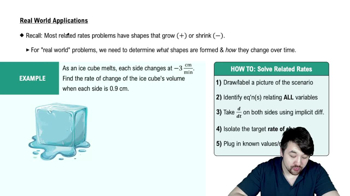Table of contents
- 0. Functions7h 52m
- Introduction to Functions16m
- Piecewise Functions10m
- Properties of Functions9m
- Common Functions1h 8m
- Transformations5m
- Combining Functions27m
- Exponent rules32m
- Exponential Functions28m
- Logarithmic Functions24m
- Properties of Logarithms34m
- Exponential & Logarithmic Equations35m
- Introduction to Trigonometric Functions38m
- Graphs of Trigonometric Functions44m
- Trigonometric Identities47m
- Inverse Trigonometric Functions48m
- 1. Limits and Continuity2h 2m
- 2. Intro to Derivatives1h 33m
- 3. Techniques of Differentiation3h 18m
- 4. Applications of Derivatives2h 38m
- 5. Graphical Applications of Derivatives6h 2m
- 6. Derivatives of Inverse, Exponential, & Logarithmic Functions2h 37m
- 7. Antiderivatives & Indefinite Integrals1h 26m
- 8. Definite Integrals4h 44m
- 9. Graphical Applications of Integrals2h 27m
- 10. Physics Applications of Integrals 2h 22m
4. Applications of Derivatives
Related Rates
Problem 3.11.49
Textbook Question
A surface ship is moving (horizontally) in a straight line at 10 km/hr. At the same time, an enemy submarine maintains a position directly below the ship while diving at an angle that is 20° below the horizontal. How fast is the submarine’s altitude decreasing?
 Verified step by step guidance
Verified step by step guidance1
First, identify the components of the submarine's velocity. The submarine is diving at an angle of 20° below the horizontal, which means its velocity can be split into horizontal and vertical components.
The horizontal component of the submarine's velocity is the same as the ship's velocity, which is 10 km/hr. This is because the submarine maintains a position directly below the ship.
To find the vertical component of the submarine's velocity, use trigonometry. The vertical component can be found using the sine function: \( v_{vertical} = v_{total} \cdot \sin(20°) \).
Since the horizontal component is 10 km/hr, use the cosine function to find the total velocity of the submarine: \( v_{total} = \frac{10}{\cos(20°)} \).
Substitute the total velocity into the equation for the vertical component: \( v_{vertical} = \frac{10}{\cos(20°)} \cdot \sin(20°) \). This will give you the rate at which the submarine's altitude is decreasing.
 Verified video answer for a similar problem:
Verified video answer for a similar problem:This video solution was recommended by our tutors as helpful for the problem above
Video duration:
5mPlay a video:
Was this helpful?
Key Concepts
Here are the essential concepts you must grasp in order to answer the question correctly.
Related Rates
Related rates involve finding the rate at which one quantity changes in relation to another. In this problem, we need to relate the horizontal speed of the ship to the vertical speed of the submarine as it dives. By using derivatives, we can establish a relationship between the rates of change of the ship's position and the submarine's altitude.
Recommended video:

Intro To Related Rates
Trigonometric Functions
Trigonometric functions, particularly sine and cosine, are essential for analyzing angles and distances in this scenario. The angle of 20° below the horizontal allows us to use these functions to determine the vertical component of the submarine's movement. Understanding how to decompose the submarine's velocity into horizontal and vertical components is crucial for solving the problem.
Recommended video:

Introduction to Trigonometric Functions
Velocity Components
Velocity components refer to breaking down a velocity vector into its horizontal and vertical parts. In this case, the submarine's velocity can be split into a horizontal component (which matches the ship's speed) and a vertical component (which represents the rate of altitude decrease). This decomposition is vital for applying the related rates concept effectively.
Recommended video:

Derivatives Applied To Velocity
Related Videos
Related Practice





